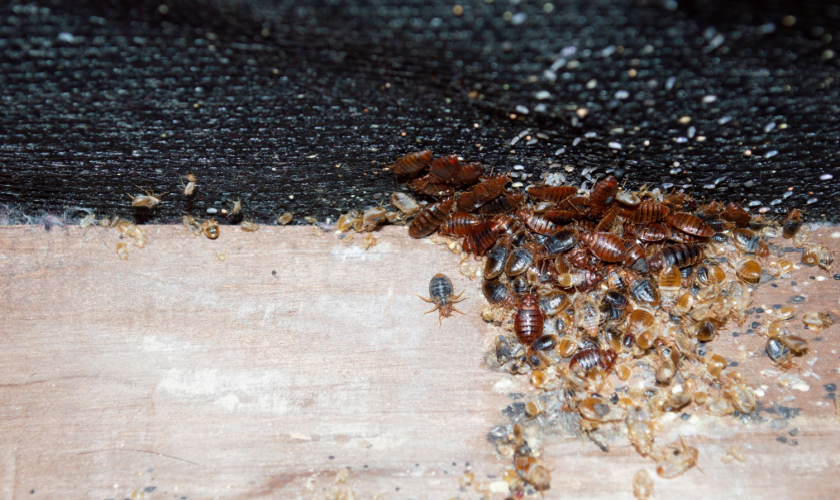Understanding the Lifecycle of Parasites for Targeted Control Methods
Recognizing the lifecycle of insects is a basic aspect of efficient parasite administration approaches. Through a much deeper understanding of just how insects progress and thrive, tailored control methods can be made to deal with certain factors in their lifecycle, ultimately leading to more effective bug monitoring results.
Relevance of Recognizing Insect Lifecycle
Understanding the lifecycle of insects is crucial for establishing reliable and targeted control methods in insect monitoring. By understanding the different stages a pest experiences from egg to grownup, bug control professionals can determine weak spots in the lifecycle where treatment can be most effective. Recognizing when larvae are most energetic can aid establish the optimal timing for applying larvicides. Additionally, understanding the lifespan of an insect types can help in anticipating population growth patterns and prospective invasion dangers.
In addition, identifying the certain environmental problems needed for each and every phase of the bug's lifecycle can assist decisions on habitat alteration or exemption techniques to lower and interfere with the lifecycle bug populations. This understanding makes it possible for pest monitoring professionals to implement aggressive steps as opposed to counting exclusively on reactive therapies, causing more long-term and lasting insect control solutions. Inevitably, a complete understanding of insect lifecycles encourages bug control specialists to customize their techniques effectively, making the most of and minimizing environmental impacts control results.
Trick Stages in Parasite Advancement
To efficiently apply targeted control techniques in parasite management, a critical aspect hinges on comprehensively determining and recognizing the essential phases in parasite development. Bug development usually contains several essential phases that are crucial for their lifecycle and administration. The initial stage is the egg stage, where bugs lay eggs that later on hatch out into larvae. Larvae then advance right into pupae, a stage where they undergo metamorphosis prior to arising as grown-up pests. Comprehending these phases is crucial as it helps in identifying weak spots in the lifecycle where control actions can be most effective.
Susceptabilities in Parasite Lifecycle
Throughout the numerous phases of a parasite's lifecycle, unique susceptabilities arise that can be tactically targeted for effective control measures. One vital susceptability depends on the egg phase, where bugs are commonly a lot more prone to specific insecticides or biological control representatives as a result of their soft outer shell, making them easier targets for treatment. In addition, the nymph or larval stage presents susceptabilities as bugs go through rapid growth and growth, needing high energy consumption that can be manipulated by interrupting their food sources or presenting development inhibitors. Pupal phases, identified by immobility and transformation, supply a home window for targeted control through physical obstacles or certain treatments that prevent effective development. Grown-up pests, while extra resilient due to their reproductive ability, can still be susceptible throughout mating or egg-laying tasks, which can be interrupted via pheromone catches or sterilization strategies. Comprehending these susceptabilities in the insect lifecycle is essential for establishing efficient and exact control strategies that successfully manage bug populaces while reducing ecological impact.
Applying Targeted Control Steps
Applying targeted control steps commonly involves a multi-faceted approach. This may consist of environment modification to make the atmosphere much less hospitable to insects, such as getting rid of standing water for mosquito control or sealing entrance factors for rats. Additionally, biological control approaches can be made use of, where natural predators or microorganisms are presented to keep insect populations in check.
Chemical control, such as the mindful application of pesticides, is another typical method. Nonetheless, it is necessary to utilize these compounds deliberately to minimize environmental influence and potential harm to non-target species. Integrated Pest Management (IPM) strategies that combine various control measures in a coordinated and lasting fashion are usually one of the most efficient in accomplishing long-lasting insect management goals. By implementing targeted control measures based upon a thorough understanding of pest lifecycles, parasite populaces can be successfully managed while lessening dangers to human health and the environment.
Enhanced Parasite Administration Practices

In addition, the consolidation of biological control representatives, such as natural killers or pathogens of bugs, can help in reducing reliance on chemical pesticides and advertise a more well balanced community. Applying physical barriers and catches can also become part of enhanced bug management methods, supplying non-toxic and targeted remedies for pest control. In addition, the use of A1 Bed bug exterminator houston LLC pheromones and various other semiochemicals can disrupt pest breeding patterns and interaction, resulting in lowered pest populaces with time.
Conclusion
By identifying essential stages in bug advancement and susceptabilities in their lifecycle, targeted control actions can be applied to decrease pest populations. Enhanced pest management practices can help reduce the reliance on broad-spectrum pesticides and advertise even more lasting and eco pleasant insect control techniques.
Comprehending the lifecycle of insects is important for developing effective and targeted control strategies in pest management. By understanding the numerous phases an insect goes through from egg to adult, pest control specialists can recognize prone points in the lifecycle where intervention can be most successful. Inevitably, a complete understanding of bug lifecycles equips insect control practitioners to customize their methods successfully, optimizing and reducing environmental influences control results.
By implementing targeted control actions based on a complete understanding of insect lifecycles, pest populaces can be efficiently controlled while lessening risks to human wellness and the atmosphere.
By identifying vital stages in parasite advancement and vulnerabilities in their lifecycle, targeted control procedures can be executed to decrease insect populaces.